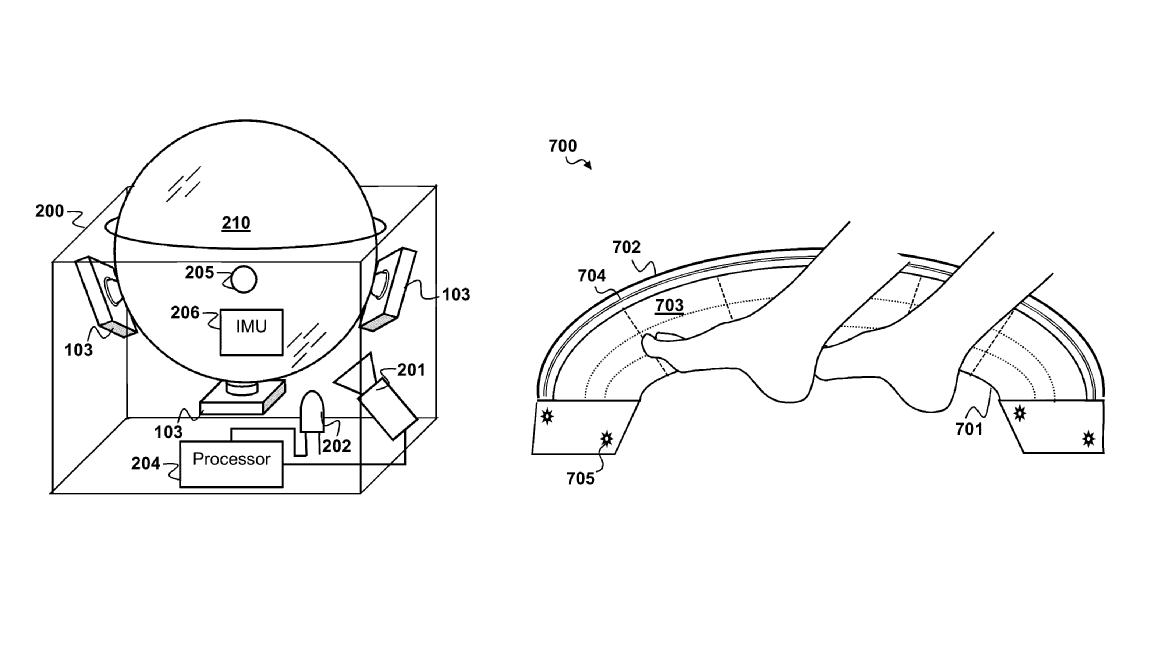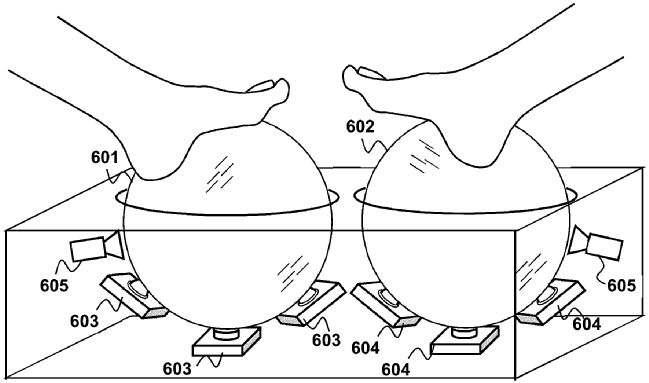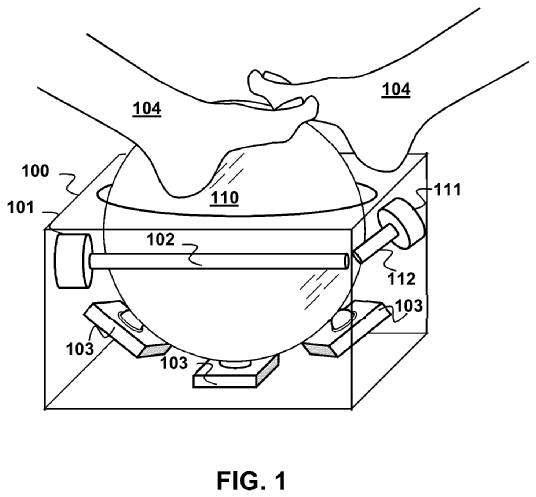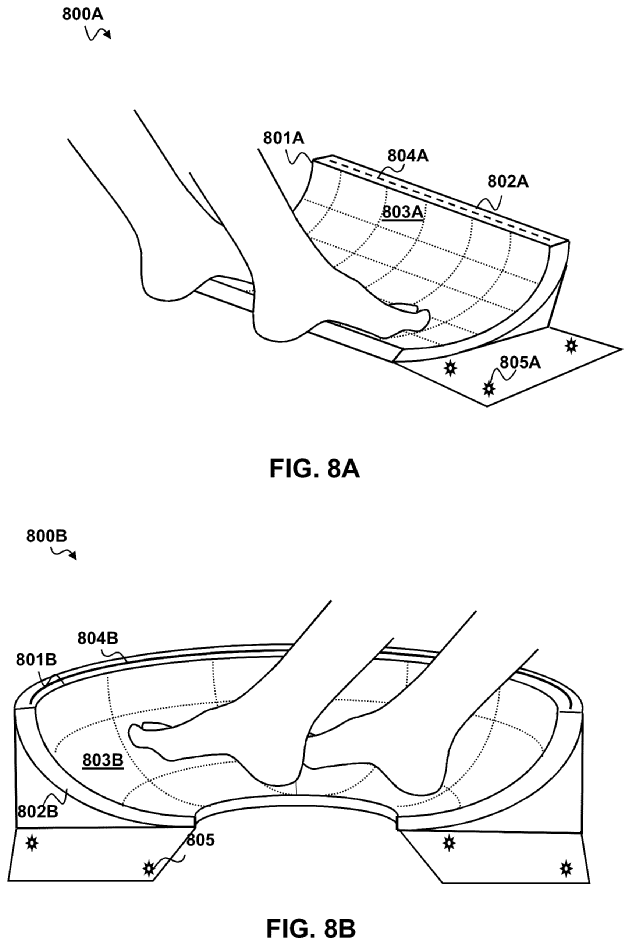Sony sticks its foot into VR — patent reveals trackball foot controller that boosts immersion for players in smaller rooms
Sony aims to solve the challenge of immersive play in space-constrained environments.

Sony has submitted patents that show plans for two types of foot-operated controllers for Augmented Reality (AR) and Virtual Reality (VR) games and other immersive applications. Several drawings in the patent show these movement-reading peripherals - one using a ball (or two), and the second using a touch-sensitive surface, both are designed to be operated by the user's feet.
The one or two ball-operated devices seem to be meant for simple movement. Meanwhile, the touch-sensitive pads with proximity-sensing capabilities can provide more complex controls. According to the patent, both types of controllers may have a built-in CPU, and memory, to calculate and translate input movement to the user's game or application.


Accompanying the images above, Sony describes a controller with either one or two balls large enough to be used by the user's foot. This works similarly to an old-school PC trackball, except Sony's devices are controlled by the user's feet. These controllers will have three or more bearings inside the ball housing which allows for smoother rotation. The processing unit in the device takes advantage of one or two encoders for each of the two balls, which calculates its rotational movement which is then used in the game.

The patent source also includes a description and images of a semi-circular bowl-type foot controller design that includes a flat touchpad which may include a curved touch-sensitive surface big enough to be operated with both feet. This will either be a capacitive or a resistive touch-sensitive surface.
Interestingly, according to the patent, the surface can also be used to sense an object nearing a capacitive foot controller, which is then used by a trigger circuit to determine a specific level of the output state. An oscillator determines the distance between the object and the controller and outputs the sensitivity to be used in the game. This also looks to be more compact and has no mechanical apparatus internally.
Benefits of AR/VR controllers like this
Sony specified these controllers will be used for AR / VR applications and games. This device addresses the challenge where the user's movement is limited to the size and free space in the room. Those living with limited space can use any one of these controllers since the user will effectively be stationary for movement, and use controllers for other in-game actions. This is also a much better solution than using a joystick or a D-pad for movements in an AR/ VR environment as it should feel more natural and immersive.
These controller devices will contain CPU, memory, analog-to-digital and digital-to-analog converters, voltage regulators, and power management which helps the controller to work independently to calculate the movement, approximation, and position of the user. The system also sends the necessary data to the host, which will then be used by the AR / VR game. Sony said these controllers may be used by an embedded system, mobile phone, PC, tablet, portable game system, workstation, game console, or any device, though that largely depends on Sony's will to allow third parties to use its controllers.
Get Tom's Hardware's best news and in-depth reviews, straight to your inbox.
Sony's patent was filed on June 10, 2022, and was published just a few days ago. Senior hardware engineers Glenn Black, Celeste Bean, Sergey Bashkirov, and Michael Taylor invented this device.
It is not known if and when will Sony roll out any foot controllers, but having a patent published usually accelerates the process of designing a few prototypes and pre-production samples. Sony may have both ball-operated and touch-sensitive pad-based controllers with proximity-sensing capability for AR/ VR movements. There were many AR / VR peripherals for allowing movement while being stationary like the Omni One VR platform. But something like this is far more compact, practical, and storage-friendly for a home user. Given the sophistication of the device mentioned in the patent, Sony is determined to provide an accurate and smooth range of movement for a seamless experience. This may solve the inconvenience for a home user who wishes to play an AR/ VR game.
From cleaning the ball of an analog mouse to potentially cleaning the ball of an AR/VR foot controller. We may have reached a full circle for ball-operated input peripherals.

Roshan Ashraf Shaikh has been in the Indian PC hardware community since the early 2000s and has been building PCs, contributing to many Indian tech forums, & blogs. He operated Hardware BBQ for 11 years and wrote news for eTeknix & TweakTown before joining Tom's Hardware team. Besides tech, he is interested in fighting games, movies, anime, and mechanical watches.
-
hotaru251 Sony: "Introducing our PSBalls for the low price of $300 each!Reply
now that its out of my system....sony is smoking soemthing.
This is dumb. -
GoofyOne Robots are in early stages at present, but we can all imagine the day when robots will do most of the work that is currently performed by humans.Reply
When that happens, what will humans do ... play games of course. To that end I think Sony, or some other company, should think bigger. To help people stay active playing games, have larger trackball/trackpad devices so people actually have to walk/jog to move their character in the game. Other sensors could track eye, head, arm, hand movements etc.